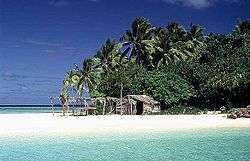Geography of Tonga


Located in Oceania, Tonga is an archipelago in the South Pacific Ocean, directly south of Western Samoa and about two-thirds of the way from Hawaii to New Zealand. It has 176 islands, 36 of them inhabited, are divided into three main groups – Vava'u, Ha'apai, and Tongatapu – and cover an 800-kilometre (500-mile)-long north-south line.
The largest island, Tongatapu, on which the capital city of Nukuʻalofa is located, covers 257 square kilometres (99 sq mi). Geologically the Tongan islands are of two types: most have a limestone base formed from uplifted coral formations; others consist of limestone overlaying a volcanic base.
Climate
The climate is tropical with a distinct warm period (December–April), during which the temperatures rise above 32 °C (89.6 °F), and a cooler period (May–November), with temperatures rarely rising above 27 °C (80.6 °F). The temperature increases from 23 to 27 °C (73.4 to 80.6 °F), and the annual rainfall is from 1,700 to 2,970 millimetres (66.9 to 116.9 inches) as one moves from Tongatapu in the south to the more northerly islands closer to the Equator. The average wettest period is around March with on average 263 mm (10.4 in).[1] The average daily humidity is 80%.
Geology
Though administratively divided into the three main island groups of Tongatapu, Ha'apai, and Vava'u (excluding the outlying islands), the Tonga archipelago is actually made of two geologically different parallel chains of islands.
The western islands, such as 'Ata, Fonuafo'ou, Tofua, Kao, Lata'iki, Late, Fonualei, Toku, Niuatoputapu, and Tafahi, make up the Tongan Volcanic Arch and are all of volcanic origin.[2] They were created from the subduction of the western-moving Pacific plate under the Australia-India plate at the Tonga Trench. The Tongan Islands sit on the Australia-India plate just west of the Tonga Trench. These volcanoes are formed when materials in the descending Pacific plate heat and rise to the surface. There is only limited coral reef development on these islands, except for Niuatoputapu.[2]
The eastern islands are nonvolcanic and sit above the mostly submerged Tonga ridge that runs parallel to the Tongan Volcanic Arch and the Tongan Trench. Of these islands, only 'Eua has risen high enough to expose its underlying Eocene volcanic bedrock, the rest are either low coral limestone islands (Tongatapu, Vava'u, Lifuka) or sand cay islands ('Uoleva, 'Uiha).[2] These islands are surrounded by "a protective and resource-rich labyrinth of fringing, apron and off-shore barrier reefs" that have supported most of the human settlement in Tonga ever since the first Lapita People arrived circa 900 BCE.[2]
The Tongan Volcanic Arc has been important in supplying the islands on the Tonga ridge with an andesite tephra soil that has resulted in "an extremely rich soil capable of supporting a high-yield, short-fallow agricultural system." Also, the andesite/basalt from the volcanoes were initially used as "hammerstones, weaving weights, cooking stones, and decorative pebbles for grave decoration."[2] Tafahi island in the far north provided volcanic glass to initial human settlers.[2]
In December 2014 and January 2015, a volcanic island 1 km wide by 2 km long was created adjacent to the island of Hunga Ha'apai 65 kilometers northwest of Nuku'alofa. The volcanic eruption has built the new island to a height of 100 m composed of ash and large rock fragments.[3]
Facts

Geographic coordinates: 20°S 175°W / 20°S 175°W
Map references: Oceania, archipelago in the South Pacific Ocean, about two-thirds of the way from Hawaii to New Zealand.
Area:
total: 747 km2 (288 sq mi)
land: 717 km2 (277 sq mi)
water: 30 km2 (12 sq mi)
Land boundaries: 0 km (0 mi)
Coastline: 419 km (260 mi)
Maritime claims:
continental shelf:
200 m (656 ft) depth or to the depth of exploitation
exclusive economic zone:
200 nmi (370.4 km; 230.2 mi)
territorial sea:
12 nmi (22.2 km; 13.8 mi)
Climate: tropical; modified by trade winds; warm season (December to May), cool season (May to December)
Terrain: most islands have limestone base formed from uplifted coral formation; others have limestone overlying volcanic base
Elevation extremes:
lowest point:
Pacific Ocean 0 m (0 ft)
highest point:
unnamed location on Kao 1,033 m (3,389 ft)
Natural resources: fish, fertile soil
Land use:
arable land:
21.33%
permanent crops:
14.67%
other:
64.00% (2011)
Irrigated land: N/A
Natural hazards:
cyclones (October to April); earthquakes and volcanic activity at Fonuafo'ou (Falcon Shoal/Island) and Late'iki (Metis Shoal/Island)
volcanism: moderate volcanic activity; Fonualei (elev. 180 m) has shown frequent activity in recent years, while Niuafo'ou (elev. 260 m), which last erupted in 1985, has forced evacuations; other historically active volcanoes include Late and Tofua
Environment - current issues: deforestation results as more and more land is being cleared for agriculture and settlement; some damage to coral reefs from starfish and indiscriminate coral and shell collectors; overhunting threatens native sea turtle populations
Environment - international agreements:
party to:
Biodiversity, Climate Change, Climate Change Kyoto-Protocol, Desertification, Law of the Sea, Marine Dumping, Marine Life Conservation, Ozone Layer Protection, Ship Pollution
signed, but not ratified:
none of the selected agreements
Geography - note:
archipelago of 169 islands (36 inhabited)

See also
References
- ↑ "Climate Guides - Plan Your Ideal Holiday Trip". Weather2Travel. Retrieved 2012-08-17.
- 1 2 3 4 5 6 David V. Burley, Tongan Archaeology and the Tongan Past, 2850-150 B.P, Journal of World Prehistory, Vol. 12, No. 3 (September 1998)
- ↑ "D news". Retrieved January 21, 2015.
- ↑ https://www.cia.gov/library/publications/the-world-factbook/geos/countrytemplate_tn.html
Sources
 This article incorporates public domain material from websites or documents of the United States Department of State.
This article incorporates public domain material from websites or documents of the United States Department of State.- World Factbook
| ||||||||||||||